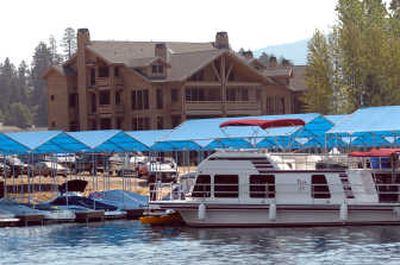Hopeful development

DOVER, Idaho – This town was born twice.
Seemingly overnight, dozens of buildings popped up in the meadows, marsh and cutover forest on the waterfront where Lake Pend Oreille flows into the Pend Oreille River. That was 1922 and shortly after a sawmill downstream in Laclede had been destroyed by fire.
Rather than rebuild on the same spot, the mill owner had the workers’ homes – along with a church and community hall – floated upriver on barges and hauled to their present-day sites by teams of horses.
That’s when Dover started.
Two years ago, construction began on a massive new housing development here. The site covers 285 acres – dwarfing the neighboring cluster of old millworker homes – and will eventually include about 500 new condominiums, cabins and high-end waterfront homes.
For better or worse, Dover is a dramatically different place.
Now, though, the homes aren’t floating in. The people are. They’re coming from Chicago, Spokane, Silicon Valley, even Singapore.
In five years or so, the project is expected to be completed and Dover will have at least 1,000 more residents, more than double the current size. Total property values in the city are expected to be assessed in the $450 million range, compared with $10 million before the Dover Bay project began, according to developer Ralph Sletager.
The heartaches brought on by such a civic shift aren’t lost on Sletager, who worked at the old Dover sawmill decades ago during college breaks.
“The change is coming,” Sletager said. “We can help direct that to produce something we can all enjoy.”
Unlike some other high-end housing developments sprouting on the shores of Inland Northwest lakes, Dover Bay has no walls or gates. The project includes nine miles of public trails, plus 3,000 feet of public beach, new parks and a new city hall. More than half of the project has been set aside as open space. Sletager said he’s trying his best to fuse new and old Dover.
“I grew up here,” he said. “To do an exclusive deal where I gate and wall off an area of people I’d known and grown up with wasn’t something I felt good about doing.”
Mayor Randy Curless said longtime residents, especially those on fixed incomes, are terrified by the prospect of rising property tax bills brought on by the development. But the same is true for most property in North Idaho, Curless said.
“Change is difficult for us all,” he said. “But this was something that was inevitable, and this was by far the best project that had ever been presented to the city for those lands.”
The winding streets of Dover Bay are covered with fresh asphalt. They pass through 10 neighborhoods in different stages of completion. There are two-bedroom cabins in the woods that fetch $500,000 and clusters of waterfront condominiums, including a four-bedroom, four-fireplace penthouse with an asking price just under $1.2 million. A café is being built at the new marina, which will eventually have 274 slips.
Where the development meets the old portion of Dover is a neighborhood of smaller cottages, which range from $298,000 to $489,000. Real estate agent Gil Harris, with Tomlinson Sandpoint, said the cottages borrowed design elements from Dover’s original homes. Harris described the cottages as “transitional architecture.”
Buyers are attracted to Dover Bay, Harris said, because of its proximity to Sandpoint and its emphasis on open space, trails and water. “It’s totally in tune with nature.”
That’s what drew Spokane physicians Terry Rempel and Anni Brandt to Dover Bay. The couple bought a condominium in the development in February as a weekend retreat.
“They’ve done a very good job of trying to do it right and make it blend in,” Rempel said on a recent Saturday as he and Brandt launched kayaks on one of the waterways crossing the development. The couple can essentially paddle from their porch to the lake, passing through wetlands where moose munch on water plants.
Rempel said the development’s lack of gates was another selling point. “I don’t want to live in a walled-off ghetto,” he said, before paddling away.
The development doesn’t have gates, but that doesn’t mean old and new Dover have become one community, said Councilwoman Peggy Burge, who lives in one of the barged-in homes.
“I haven’t met any of them,” Burge said of the new residents.
Burge, who cast the lone vote against the development when it was approved by the council in 2004, said she doesn’t fault Dover Bay or the new residents for the change or for moving to a beautiful part of the West – Burge came from Ohio. But there’s an unmistakable sadness in her voice when she describes the old Dover.
Once upon a time, each new baby in Dover received a quilt from a local grandmother, Burge said. On Halloween, the older Dover kids were given full-sized candy bars – outsiders received standard-issue, bite-sized bars. Summer afternoons were marked by picnics on a sandy beach and baseball games.
“What I knew as Dover is not here anymore, and it will never be,” Burge said, adding, “There’s no turning back now.”